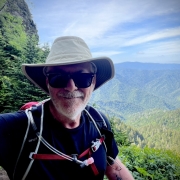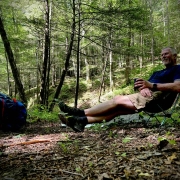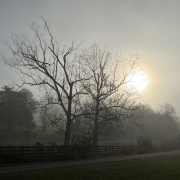Breaking Up (with Food) is Hard to Do – The Mark Neese Version | Healthy Aging Series: Season 9, Episode 1
[Verse 1]
Don’t take my food away from me!
Don’t you leave my stomach in misery?
If it goes then I’ll be blue!
‘Cuz breaking up (with food) is hard to do.
[Verse 2]
Remembering how it taste so good.
I even dream of full plates of food.
Think of all that we’ve been through.
And breaking up with food is hard to do!
[Chorus]
They say that breaking up with food is hard to do,
Now, I know, I know that it’s true!
I lost some weight, but now it’s back!
Instead of breaking up, I think I’ll have another stack (of cookies)!
[Verse 3]
I beg of you, don’t say goodbye!
Why can’t I have another piece of pie?
Come on, donuts, let’s start a new!
‘Cuz breaking up (with food) is hard to do!
[Chorus]
They say that breaking up with food is hard to do
Now, I know, I know that it’s true!
Why can’t I keep off all those pounds!
Instead of breaking up, I think I’ll have another Mounds (Bar)
[Verse 4]
I beg of you, don’t say goodbye!
Can’t I have another order of fries?
Come on, sugar, let’s start anew!
‘Cuz breaking up with food is hard to do
The original “Breaking Up Is Hard to Do” is a song recorded by Neil Sedaka, co-written by Sedaka and Howard Greenfield. Sedaka recorded this song twice, in 1962 and 1975, in two significantly different arrangements, and it is considered to be his signature song. -Wikipedia
Why is it so hard to lose weight AND keep it off?
You know the drill. Over the course of 3 or 4 years, you put on an extra 20 lbs. You get tired of seeing yourself in the mirror. You muster up the motivation to start a weight reduction diet, something healthy like the Whole 30 Diet. There are several healthy diets, but the Whole 30 has worked for me.
You set a goal to lose 20 lbs. and give yourself 8 to 12 weeks to lose those pounds.
You struggle. You experience diet fatigue. You add an exercise regimen to the weight loss plan. And slowly, you lose the weight. As each week goes by, you’re amazed that your clothes are fitting better and you’re able to wear clothes that you never thought you’d wear again. You feel great. You’ve been able to show discipline over your appetites and control over food.
Now comes the depressing part.
A year later you gained all the weight back. All of it. In fact, you settle in at the same weight that you were when you started the diet.
And this isn’t the first time you’ve done this. You’ve lost weight before. Six months or a year later you’re back at the same weight. It feels like a yo-yo.
There are some that refer to this weight that you always come back to as your Set Weight Point (SWP).
There was a recent Ted Talk that attempted to explain the SWP. The speaker explained that the SWP is mostly genetic and is “hard-wired” into our bodies.
“The set point theory says that the body will settle at a specific weight where it likes to be,” says MD Anderson Senior Exercise Physiologist Carol Harrison. “And it will defend itself so that it stays at this specific weight.”
“The set point is established over a long period of time,” says Harrison. “It’s a very complex thing, but it appears that it is your body’s attempt to regulate itself, and that attempt results in a certain weight.”
I want to propose a different way of looking at SWP. Your SWP reflects the kind relationship that you have with food.
Your SWP reflects the patterns and routines that you develop with food over the course of your life. These patterns include what you eat, how much you eat, where you eat, how often you eat, who you eat with.
Food comforts us. It brings us pleasure. Much of our social life revolves around food. We think about it even when we’re not hungry. We eat when we are angry, or sad, or happy. We have an emotional attachment to food.
At times, we have a toxic or dysfunctional relationship with food! And it’s a difficult relationship to change.
If you want to change the how, what, when, where, and why about food, then you must change your relationship with food.
Maybe we need to have a “break up” with food and by break up I mean changing how we live our lives with food.
Think about being in a toxic friendship. You can’t simply keep seeing the person, talking to them, and spending time with them and then expect that it’s going improve without addressing the things about that friendship that make it toxic.
Maybe your relationship with food isn’t toxic but, at a minimum, it’s dysfunctional.
This season was originally intended to be one episode in Season 9 but as I read and wrote, the episodes grew and there will be at least 12 episodes.
I’ve included several episodes from “obesity memoirs,” from people who struggled with obesity, had a breakup with food and maintained that breakup.
There are two books that I devoured (sorry for the pun) during my reading this season. One helps you change the way you think about food and yourself, “The Beck Diet.” And the other is “Dopamine Nation,” which will help you understand that you can be addicted to food.
In Episode 3, I explain what it means to have a dysfunctional relationship with food.
In Episode 5, I explain why is so difficult to break up with food.
Starting with Episode 7, I give several cognitive-behavioral strategies that will help you in the breakup process.
In Episode 2, my next episode I share an “obesity memoir” entitled, “It was Me all Along,” by Andie Mitchell. A wonderful story about a woman’s breakup with food.
To read more entries in the Healthy Aging series, click here.






